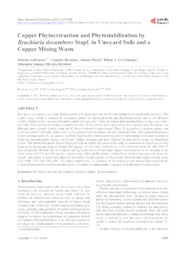Copper phytoextraction and phytostabilization by Brachiaria decumbens Stapf. in vineyard soils and a copper mining waste.
Copper phytoextraction and phytostabilization by Brachiaria decumbens Stapf. in vineyard soils and a copper mining waste.
Autoria: ANDREAZZA, R.; BORTOLON, L.; PIENIZ, S.; CAMARGO, F. A. O.; BORTOLON, E. S. O.
Resumo: Brachiaria decumbens is a high biomass plant with great potential for phytoremediation of copper-polluted soils. The current study aimed to evaluate B. decumbens plants for phytoextraction and phytostabilization use in two different copper contaminated vineyard soils and a copper mining waste. Also, the macro and micronutrients uptake were evalu- ated after plants growth in copper contaminated soils. B. decumbens was cultivated in two vineyard soils (Inceptisol and Mollisol) and a copper mining waste for 47 days of growth in greenhouse. Then, B. decumbens?s nutrient uptake was evaluated, and it?s potential application in phytoremediation techniques for the phytoextraction and phytostabilization of copper contamination. B. decumbens exhibited high levels of biomass production at contaminated soils and no negative effect on macronutrients uptake was found. Copper contaminated soils affected micronutrients uptake by Brachiaria plants. This Brachiaria specie showed high potential on copper phytoextraction with accumulation of copper concentra- tions in the shoots and roots of 70 and 585 mg·kg?1 of dry mass, respectively, in the vineyard Inceptisol soil, after 47 days of growth. Mollisol soil and copper mining waste also exhibited high copper concentration in the biomass in the entire plant with 371 and 466 mg·kg?1, respectively. Although Brachiaria exhibited low levels of translocation factor for copper, this specie showed high potential for copper phytoextraction on Inceptisol, Mollisol and copper mining waste with 1900, 1156 and 1363 g·ha?1 of copper, respectively. In summary, B. decumbens plants showed high potential for copper phytoextraction and phytostabilization of copper on contaminated vineyard soils and copper mining waste.
Ano de publicação: 2013
Tipo de publicação: Artigo de periódico
Unidade: Embrapa Pesca e Aquicultura
Palavras-chave: Absorção de nutrientes, Bioremediation, Brachiaria decumbens, Cobre, Metal pesado, Nutrient uptake, Poluição, Soil pollution, Solo
Observações
1 - Por padrão são exibidas publicações dos últimos 20 anos. Para encontrar publicações mais antigas, configure o filtro ano de publicação, colocando o ano a partir do qual você deseja encontrar publicações. O filtro está na coluna da esquerda na busca acima.
2 - Para ler algumas publicações da Embrapa (apenas as que estão em formato ePub), é necessário ter, no celular ou computador, um desses softwares gratuitos. Sistemas Android: Google Play Livros; IOS: iBooks; Windows e Linux: software Calibre.
Acesse outras publicações
Acesse a Base de Dados da Pesquisa Agropecuária (BDPA) para consultar o acervo completo das bibliotecas da Embrapa.

